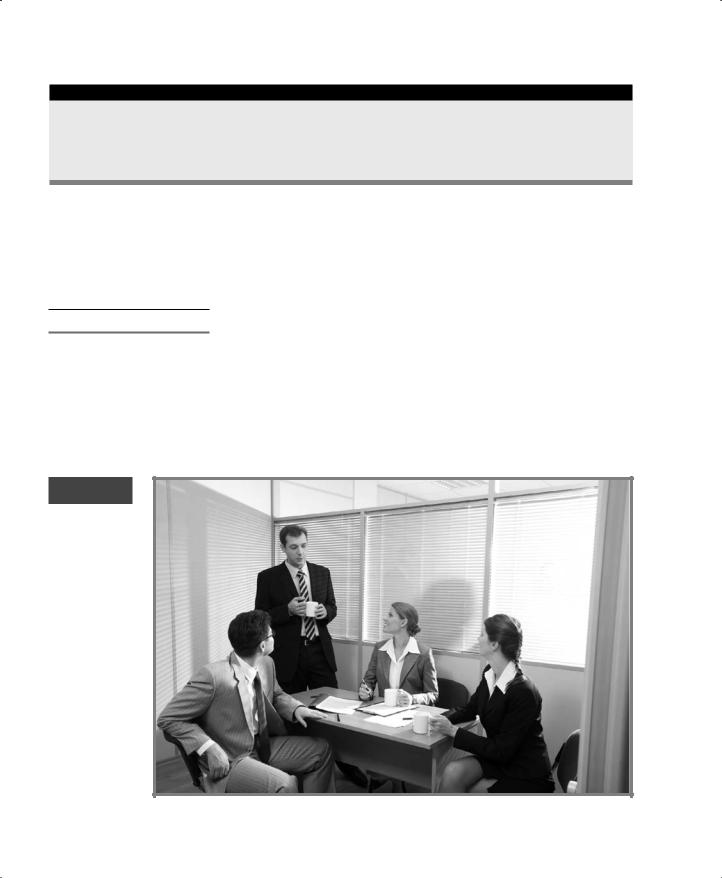
- •Contents
- •Preface
- •Acknowledgments
- •Founders of the Hotel Industry
- •E. M. Statler
- •Conrad Hilton
- •Cesar Ritz
- •William Waldorf Astor and John Jacob Astor IV
- •Kemmons Wilson
- •Ernest Henderson and Robert Moore
- •Ray Schultz
- •Historical Developments
- •Atrium Concept
- •Select-Service Hotels
- •Technological Advances
- •Marketing Emphasis
- •Total Quality Management
- •Major Reorganization, 1987–1988
- •Hotel Investment
- •September 11, 2001
- •Economic Downturn of the Late 2000s
- •Overview of the Hotel Industry
- •Types of Lodging Facilities
- •Hotels
- •Motels
- •All-suites
- •Select-service Hotels
- •Extended-stay Hotels
- •Market Orientation
- •Sales Indicators
- •Occupancy
- •Average Daily Rate (Average Room Rate)
- •Yield Percentage
- •RevPAR (Revenue per Available Room)
- •Levels of Service
- •Business Affiliations
- •Chain Affiliation
- •Referral Property
- •Company-owned Property
- •Management Contract Property
- •Brands
- •Independent Properties
- •Trends That Foster Growth
- •Leisure Time
- •The Me/Pleasure Concept
- •Discretionary Income
- •Family Size/Household Size
- •Business Travel
- •Female Business Travel
- •Travel as Experience
- •Career Development
- •Educational Preparation
- •Work Experience
- •Professional Memberships
- •Ports of Entry
- •Researching Growth Areas in the Hospitality Industry
- •Solution to Opening Dilemma
- •Chapter Recap
- •End-of-Chapter Questions
- •Notes
- •Key Words
- •Organization of Lodging Properties
- •Organization Charts
- •Typical Job Responsibilities of Department Managers
- •General Manager
- •Assistant General Manager
- •Food and Beverage Director
- •Physical Plant Engineer
- •Executive Housekeeper
- •Human Resources Manager
- •Marketing and Sales Director
- •Front Office Manager
- •Controller
- •Director of Security
- •Parking Garage Manager
- •Organization of the Front Office Department
- •Typical Front Office Organization
- •Select-service Hotel Front Office Organization
- •Function of the Front Office Manager
- •Job Analysis and Job Description
- •The Art of Supervising
- •Staffing the Front Office
- •Solution to Opening Dilemma
- •Chapter Recap
- •End-of-Chapter Questions
- •Key Words
- •Role of the Front Office in Interdepartmental Communications
- •Front Office Interaction with Other Departments in the Hotel
- •Marketing and Sales Department
- •Housekeeping Department
- •Food and Beverage Department
- •Banquet Department
- •Controller
- •Maintenance or Engineering Department
- •Security Department
- •Human Resources Management Department
- •Analyzing the Lines of Communications
- •Situation 1: Marketing and Sales Knows It All—But Didn’t Tell Us
- •Situation 2: Peace and Harmony in 507
- •Situation 3: I Know What You Said, and I Think I Know What You Mean
- •The Role of Total Quality Management in Effective Communication
- •An Example of Total Quality Management in a Hotel
- •Solution to Opening Dilemma
- •Chapter Recap
- •End-of-Chapter Questions
- •Key Words
- •Physical Structure and Positioning of the Front Desk
- •Guest First Impression
- •Creating a Balance Between Guest Flow and Employee Work
- •Selecting a Property Management System
- •Importance of a Needs Analysis
- •Procedure for Performing a Needs Analysis
- •Selecting a Team
- •Analyzing the Flow of Guests through the Hotel
- •Communicating Information
- •Reviewing Administrative Paperwork
- •Management Review of Information
- •Evaluate Needs That Have Been Identified
- •Assessing Needs Based on Findings
- •Choosing Software
- •Choosing Hardware
- •Other PMS Selection Considerations
- •Vendor Claims
- •Hardware Installation Plans
- •Computer Training Programs
- •Backup Power Sources
- •Maintenance Agreement
- •Financial Considerations
- •PMS Applications
- •Reservations
- •Revenue Management
- •Registration
- •Room Status
- •Posting
- •Call Accounting
- •Checkout
- •Night Audit
- •Inquiries/Reports
- •Back Office
- •Housekeeping
- •Food and Beverage
- •Maintenance
- •Security
- •Marketing and Sales
- •Personnel
- •Electronic Mail
- •Time Clock
- •Solution to Opening Dilemma
- •Chapter Recap
- •End-of-Chapter Questions
- •Notes
- •Key Words
- •Importance of a Reservation System
- •Overview of the Reservation System
- •Choice Hotels International
- •Hilton Hotels
- •Marriott International
- •Global Distribution Systems (GDS) in Securing Reservations
- •Role of the Internet in Securing Reservations
- •Background on Room Rates Offered via the Internet
- •Effect of Internet on Pricing Rooms
- •Consumers Response to Use of the Internet—Third-Party Websites
- •Social Media
- •Financial Effects of Third-Party Reservations
- •Types of Reservation Systems
- •Franchisee
- •Referral Member
- •Sources of Reservations
- •Corporate Clients
- •Social/Military/Educational/Religious/Fraternal (SMERF)
- •Meetings/Incentive/Conference/Event (MICE)
- •Group Travelers
- •Leisure Travelers
- •Current Guests
- •Forecasting Reservations
- •Overbooking (Occupancy Management)
- •Revenue Management
- •Processing Guest Reservations
- •Systemwide Reservation Systems
- •Outsourcing Reservations
- •Types of Reservations
- •Reservation Codes
- •Cancellation Codes
- •Blocking Procedure
- •Process of Completing Reservations through a PMS
- •Database Interfaces
- •True Integration
- •Solution to Opening Dilemma
- •Chapter Recap
- •End-of-Chapter Questions
- •Notes
- •Key Words
- •Occupancy Percentage
- •Average Daily Rate
- •RevPAR
- •History of Yield Management
- •Use of Yield Management
- •Revenue Manager
- •Components of Revenue Management
- •Definition of Yield
- •Optimal Occupancy and Optimal Rate
- •Strategies
- •Forecasting
- •Star Report
- •Block-out Periods
- •Systems and Procedures
- •Channel Management
- •Feedback
- •Management Challenges in Using Revenue Management
- •Considerations for Food and Beverage Sales
- •Applications of Revenue Management
- •Scenario 1
- •Scenario 2
- •Scenario 3
- •Solution to Opening Dilemma
- •Chapter Recap
- •End-of-Chapter Questions
- •Notes
- •Key Words
- •Importance of the First Guest Contact
- •Components of the Registration Process
- •Capturing Guest Data
- •Guest Registration Procedure
- •Guest Hospitality
- •Inquiry about Reservation
- •Completion of Registration Card
- •Review Completeness of Registration Card
- •Extension of Guest Credit
- •Room Selection
- •Room Assignment from Inventory
- •Assigning Room Rates
- •Discuss Sales Opportunities
- •Assigning Room Keys
- •Security of the Key System
- •Maintaining the Key System
- •Registration with a PMS
- •Retrieving Reservation Form
- •Checking Room Inventory Option
- •Checking Room Status Option
- •Verifying Room Rate
- •Issuing Room Key
- •Obtaining Reports from the PMS
- •Self-Check-In
- •Solution to Opening Dilemma
- •Chapter Recap
- •End-of-Chapter Questions
- •Notes
- •Key Words
- •Common Bookkeeping Practices
- •Debits and Credits
- •Forms Used to Process Guest Charges and Payments
- •Folio, Transfers, and Paid-out Slips
- •Account Ledgers
- •Guest Ledger and City Ledger
- •Posting Guest Charges and Payments
- •Point-of-sale
- •Room and Tax
- •Transfers and Adjustments
- •Paid-Out
- •Miscellaneous Charges
- •Phone
- •Display Folio
- •Reports
- •Transferring Guest and City Ledgers to Accounts Receivable
- •Solution to Opening Dilemma
- •Chapter Recap
- •End-of-Chapter Questions
- •Key Words
- •Organizing Late Charges to Ensure Accuracy
- •Guest Checkout Procedure
- •Inquiring about Quality of Products and Services
- •Retrieving the Room Key
- •Retrieving and Reviewing the Folio
- •In-room Guest Checkout
- •Determining Method of Payment and Collection
- •Credit Cards
- •Bill-to-account (Direct Billing)
- •Cash and Personal Checks
- •Traveler’s Checks
- •Debit Cards
- •Assisting the Guest with Method of Payment
- •Money Wire
- •Travelers Aid Society
- •Auto Clubs
- •International Currency Exchange
- •Obtaining Future Reservations
- •Filing Documents
- •Relaying Guest Departures to Other Departments
- •Removing Guest Information from the System
- •Transfer of Guest Accounts to the Back Office
- •Checkout Reports Available with a Property Management System
- •Guest Histories
- •ZIP Code or Postal Code
- •Developing Conventions and Conferences
- •FAM Tours
- •Origination of Reservation
- •Frequency of Guest Visit
- •Types of Room Requested
- •Room Rates versus Occupancy Patterns
- •Tracking Social Media
- •Last Impressions of the Hotel
- •Solution to Opening Dilemma
- •Chapter Recap
- •End-of-Chapter Questions
- •Notes
- •Key Words
- •Importance of the Night Audit
- •The Night Auditor
- •The Night Audit Process
- •Posting Room and Tax Charges
- •Assembling Guest Charges and Payments
- •Reconciling Departmental Financial Activities
- •Reconciling Accounts Receivable
- •Running the Trial Balance
- •Goal of Preparing the Night Audit Report
- •Preparing the Night Audit Report
- •Departmental Totals
- •Bank Deposit
- •Accounts Receivable
- •Cashier’s Report
- •Manager’s Report
- •Formulas for Balancing the Night Audit Report
- •Room and Tax
- •Total Restaurant Sales and Sales Tax
- •Tips for Restaurant, Room Service, Banquet, and Lounge Employees
- •Room Service
- •Banquet Sales
- •Banquet Bar and Total Lounge Sales
- •Room Rental
- •Valet
- •Telephone Charges
- •Gift Shop Sales and Tax
- •Vending
- •Parking
- •Total Revenue and Total Write-Offs
- •Cash Sales and Accounts Receivable Balance
- •Credit Cards and Cash Applied to Accounts Receivable
- •Analysis of Accounts Receivable
- •Bank Deposit and Amount Transferred to Accounts Receivable
- •Cashier’s Report
- •Operating Statistics
- •Daily Flash Report
- •Reading the Flash Report
- •Reading the Night Audit
- •Solution to Opening Dilemma
- •Chapter Recap
- •End-of-Chapter Questions
- •Key Words
- •Importance of Hospitality
- •Managing the Delivery of Hospitality
- •Management’s Role
- •The Service Strategy Statement
- •Financial Commitment
- •Total Quality Management Applications
- •Developing a Service Management Program
- •Guest Cycle
- •Moments of Truth in Hotel Service Management
- •Employee Buy-in Concept
- •Screening Employees Who Deliver Hospitality
- •Empowerment
- •Training for Hospitality Management
- •Evaluating the Service Management Program
- •Follow-through
- •Interfacing with Other Departments in Delivering Hospitality
- •Customer Relationship Management
- •Solution to Opening Dilemma
- •Chapter Recap
- •End-of-Chapter Questions
- •Notes
- •Key Words
- •Determining Employee Hospitality Qualities
- •Job Analysis and Job Descriptions
- •Positive Hospitality Character Traits
- •Practicing Promotional Skills
- •Screening for Hospitality Qualities
- •An Outgoing Personality
- •Patience
- •Ability to Accept Constructive Criticism
- •Interest in Selling
- •Developing an Orientation Program
- •Economic Position of the Property in the Community
- •Overview of the Lodging Establishment
- •Employee Handbook
- •Policy and Procedure Manual
- •Introduction to the Front Office Staff
- •Equipment Overview
- •Interdepartmental Cooperation
- •Administering the Orientation Program
- •Selection of Orientation Leader
- •Developing a Training Program
- •Identification of Tasks and Job Management Skills
- •Preparing Step-by-Step Procedures
- •Management Concepts
- •Steps in the Training Process
- •Preparation: Get Ready
- •Delivery: Show Me
- •Administering a Training Program
- •Cross-training
- •Developing a Trainer
- •Job Knowledge
- •Training for Empowerment
- •Americans with Disabilities Act
- •Solution to Opening Dilemma
- •Chapter Recap
- •End-of-Chapter Questions
- •Notes
- •Key Words
- •The Role of the Front Office in Marketing and Sales
- •Planning a Point-of-sale Front Office
- •Set Objectives
- •Brainstorm Areas for Promotion
- •Evaluate Alternatives
- •Devise Incentive Programs
- •Theories of Motivation
- •Douglas McGregor
- •Abraham Maslow
- •Elton Mayo
- •Frederick Herzberg
- •Applying Motivation Theories
- •Maslow
- •Mayo
- •Herzberg
- •Training Programs for a Point-of-sale Front Office
- •Train in Sales Skills
- •Develop an Attitude of Presenting Opportunities
- •Let Employees Experience Hotel Services
- •Use Role-Playing to Create Your Own Training Video
- •Budgeting for a Point-of-sale Front Office
- •Feedback
- •Guest Test
- •Financial Results
- •Planning a Point-of-sale Front Office—An Example
- •Solution to Opening Dilemma
- •Chapter Recap
- •End-of-Chapter Questions
- •Notes
- •Key Words
- •Importance of a Security Department
- •Organization of a Security Department
- •Job Analysis of the Director of Security
- •In-House Security Departments versus Contracted Security
- •Room Key Security
- •Hard-key System
- •Electronic Locks System
- •Smart Card
- •Contactless Electronic Locks
- •Fire Safety
- •General Fire Code Requirements
- •Guest Expectations
- •Fire Safety Plan
- •Employee Training in Fire Safety
- •Guest Instruction in Fire Safety
- •Fire Action Communication Procedure
- •Emergency Communication
- •Developing the Emergency Communication Plan
- •Employee Safety Programs
- •Employee Safety Committee
- •Composition and Activities of the Safety Committee
- •Department Supervisors’ Responsibility
- •Safety Training Programs
- •Solution to Opening Dilemma
- •Chapter Recap
- •End-of-Chapter Questions
- •Notes
- •Key Words
- •Importance of the Housekeeping Department
- •Overview of a Housekeeping Department
- •Relationship of the Executive Housekeeper to the General Manager
- •Management of a Housekeeping Department
- •Room Assignment/Workload
- •Outsourcing Housekeeping Activities
- •Housekeeper’s Report
- •Communication
- •Situation 1: Why Can’t Room Attendants Get Those Rooms Cleaned More Quickly, or, If That Guest Asks One More Time…
- •Inventory Control
- •Fixtures
- •Theft Control of Inventory
- •In-house Laundry versus Outsourced Laundry
- •Occupational Safety and Health Administration
- •Material Safety Data Sheets
- •Americans with Disability Compliance
- •Professional Associations
- •Role of Chief Engineer in a Lodging Property
- •Job Analysis
- •Job Description
- •Technology
- •Managing Maintenance Inter-departmental Communications
- •Energy Management
- •The Greening of the Lodging Industry
- •Leadership in Energy and Environmental Design (LEED)
- •Solution to Opening Dilemma
- •Chapter Recap
- •End-of-Chapter Questions
- •Notes
- •Key Words
- •Glossary
- •Index

320 C H A P T E R 1 1 ■ M A N A G I N G H O S P I TA L I T Y
I N T E R N A T I O N A L H I G H L I G H T S
uHotels throughout the world differ in the level of service they offer their guests. Some hotels provide the basic elements of service within standard operating procedures, while other hotels focus their efforts on delivering service. Much of the explanation for the differences relates to a
nation’s culture of service. Cultures of countries that regard service as subservience may produce employees who operate within standard operating procedures. But when service is viewed as a profession, the culture produces professionals as well as employees who welcome the opportunity to tend, facilitate, and care for the guest. Hotels that operate in countries where service is not part of the culture must develop systems that support employee success in the delivery of hospitality.
will have a negative impression of the hotel ([180 people told 1 9 original dissatisfied customers] 3 365 days), and 2190 will have a positive impression ([5 people told 1 1 original satisfied customer] 3 365 days).
The financial ramifications of so many people negatively impressed with your hotel are clearly disastrous. Hospitable treatment of guests must be more than just an option; it must be standard operating procedure. It is a concept that must be adopted as a corporate tenet and organized for effective delivery.
Managing the Delivery of Hospitality
It is not enough for the front office manager to decide the members of the front office staff should provide good service and display hospitality to guests. To provide satisfactory hospitality to all guests at all times, front office managers must develop and administer a service management program, which highlights the company’s focus on meeting customers’ needs and allows the hotel to achieve its financial goals. This program must be based on sound management principles and the hotel’s commitment to meeting guests’ needs.
Management’s Role
Management may seem an odd place to start a discussion of delivering hospitality. After all, aren’t the front desk clerks, switchboard operators, and bellhops the people who meet and greet guests and fulfill their needs at the front desk? Yes, these employees do provide hospitality directly, but managers must work behind the scenes to develop a plan that ensures employees’ efforts are continuous and professional. For example, management may decide to implement one or two specific, immediate changes on learning a guest’s needs were overlooked. Management may feel the negative impact of the rude, lazy, or careless employee has unnecessarily caused bad public relations. If a group of employees is not performing to management’s standards, the cumulative effects of the group are perceived negatively by guests. This negative impression takes a toll in the long run. Although one or two directives may correct an individual guest’s problems, the hotel will reap only short-lived gains. A comprehensive program aimed at meeting the needs of a hotel’s prime

M A N A G I N G T H E D E L I V E R Y O F H O S P I TA L I T Y 321
market—guests who continue to do business with the hotel—is the foundation for longterm successful delivery of hospitality. This is what makes a hotel profitable.
Management’s commitment to a service management program must be as integral to the organization as effective market planning, cost control programs, budgeting, and human resources management. In fact, service management is the most visible responsibility because it affects all other objectives of the hotel. Often the people in staff positions in hotels become so involved with their day-to-day paper shuffling and deadlines that they forget why they are in business. They may not mean to forget, but it happens all too often. Service management ensures a commitment to long-range effort by appointing someone within the organization to be responsible for developing, organizing, and delivering it. John W. Young, retired executive vice president of human resources at the Four Seasons Hotels and Resorts, tells us:
We expect our general managers to respect the dignity of every employee, to understand their needs and recognize their contributions, and to work to maintain their job satisfaction with us—and to encourage their growth to the maximum extent their ability and desire allows. General measurement is based on detailed employee attitude surveys, conducted by an outside firm, as well as such factors as employee turnover [and] employee promotions, both within the hotel and to other hotels. Also specific people-related goals are set according to the hotel’s needs or the manager’s personal needs, and measured, e.g., implementing a planned change in response to concerns in an attitude survey.4
The front office manager usually supervises service management efforts. Other key department heads who supervise employees who deal with guests, such as the food and beverage manager and director of marketing and sales, rely on the organizational leadership of the front office manager. It is important to note that responsibility for delivering hospitality to the guest is always a part of the job of each department’s supervisor or shift leader, the person responsible for directing the efforts of a particular work shift. The organizational efforts provided by the front office manager serve as the basis for a homogeneous plan for the hotel.
The owner and general manager must make a financial commitment to ensure the success of the program. An important component is motivating employees to deliver hospitality on a continual basis through incentive programs. Incentive programs are management’s organized efforts to determine employees’ needs and develop programs to help them meet their own needs as well as those of the hotel. Such programs reward employees for providing constant and satisfactory guest service and often involve money, in the form of bonuses, which must be budgeted in the annual projected budget. Incentives may involve the employees’ choice of a monetary bonus, higher hourly rates, shift preference, or additional holiday or vacation days.
Mark Heymann, chairman and CEO of UniFocus, based in Carrollton, Texas, believes customer satisfaction and employee satisfaction (in hotels) should be considered simultaneously. He says, “Given today’s extraordinarily tough labor market, dissatisfied workers don’t stick around. So a happy staff is the key to happy campers.” Mr. Heymann also reports on feedback from hotel property clients with UniFocus, saying, “Money is not the key driver when it comes to holding on to staff. It’s the interaction with management and the environment.”5

322 C H A P T E R 1 1 ■ M A N A G I N G H O S P I TA L I T Y
F R O N T- L I N E R E A L I T I E S
qThe daughter of an international guest approaches a front desk clerk and says her mother is experiencing chest pains. What hospitality opportunities are available to the front desk
clerk?
The goal of every lodging establishment should be to extend the same degree of hospitality to the guest who arrives on a busy Monday morning and to one who arrives on a slow Saturday night. Management’s ideological and financial commitment, along with the organizational efforts of the front office manager, will ensure both of these guests are treated equally.
The Service Strategy Statement
To produce an effective service management program, managers must devise a service strategy statement, a formal recognition by management that the hotel will strive to deliver the products and services desired by the guest in a professional manner. To accomplish this, management must first identify the guest’s needs.
Those of you who have entry-level jobs in a hotel as bellhops, desk clerks, switchboard operators, table attendants, housekeeping attendants, or gift shop clerks may have some feel for what guests want. They want quick and efficient service. They want to avoid long
F I G U R E 1 1 - 2
Owners and managers must commit financial resources
and establish priorities for the operation of a successful service management program.
Photo courtesy of iStockphoto.

M A N A G I N G T H E D E L I V E R Y O F H O S P I TA L I T Y 323
lines. They want to find their way easily around the hotel and the immediate vicinity. They want the products and services in the hotel to work. They want to feel safe and secure while residing in the hotel. If you use these observations as a basis for understanding guests’ needs while they are away from home, you will be able to better satisfy them. John Young states, “Market research, internal guest comments and our regular employee attitude surveys all confirm that what has set and will continue to set Four Seasons apart from our competitors is personal service.”6
As Eric Johnson and William Layton note, “It is only through the eyes of a customer that a definition of service quality can be obtained. Senior management cannot adequately determine what is desired at the customer level until a comprehensive evaluation of customer preference is established through a systematic consumer research study.”7 Thus, in addition to identifying generally what guests want, management should survey guests of the particular property to determine what services they expect and how they want them delivered. The general manager of the hotel may assign this task to the marketing and sales director, who may start by reviewing and summarizing customer comment cards, which are usually held on file for six months to a year. A review of the areas in which the hotel has disappointed its guests, like that shown in Figure 11-3, provides a basis for determining where to begin a guest survey. The problem areas identified from this study are then used
F I G U R E 1 1 - 3 The report highlights areas of customer service and customer feedback.
The Times Hotel
CUSTOMER COMMENT CARD SUMMARY, SEPT.–DEC.
Product/Service |
Sept. |
Oct. |
Nov. |
Dec. |
Overbooked |
41 |
20 |
8 |
20 |
Slow check-in |
50 |
31 |
12 |
25 |
Slow checkout |
10 |
15 |
10 |
4 |
Room rate too high |
10 |
7 |
9 |
8 |
Delay getting into room |
35 |
12 |
18 |
5 |
Slow room service |
90 |
3 |
3 |
10 |
Poor food in restaurant |
6 |
10 |
2 |
8 |
Poor selections on menu |
2 |
5 |
7 |
12 |
High prices on menu |
2 |
10 |
10 |
20 |
Dirty room |
3 |
4 |
8 |
15 |
Poor selection of amenities |
— |
— |
5 |
— |
Bedding insufficient |
10 |
10 |
12 |
5 |
Lack of response from housekeeping |
9 |
15 |
7 |
9 |
Rudeness from bell staff |
1 |
— |
5 |
— |
Rudeness from dining room staff |
1 |
— |
10 |
— |
|
|
|
|
|

324 C H A P T E R 1 1 ■ M A N A G I N G H O S P I TA L I T Y
F I G U R E 1 1 - 4 This individual hotel guest survey asks guests for their opinions on delivery of service.
The Times Hotel
GUEST SURVEY
1. List and rate the services provided by the bell staff.
excellent good fair poor excellent good fair poor
2. List and rate the services provided by the front desk.
excellent good fair poor excellent good fair poor excellent good fair poor
3. List and rate the services provided by housekeeping.
excellent good fair poor excellent good fair poor
4. List and rate the services provided by the food and beverage department.
excellent good fair poor excellent good fair poor excellent good fair poor
as the focus of a simple survey form similar to that shown in Figure 11-4. Keep in mind that historical data provided by surveys is essential for building a plan on service management. However, managing the daily challenges of employee requests for improvement of service is always a responsibility of front-line employees, supervisors, and managers.
The survey may be administered by a member of the marketing and sales department at various times during the day. The resulting data, as well as that gleaned from comment cards, gives a general indication of what guests want. Sometimes pinpointing guest needs is not easy, because they change over time. In the example shown in Figure 11-3, speed of service delivery, high prices, poor selection of products, low-quality products, and rude personnel are problem areas. These areas, then, should be the focus of the service strategy statement, as they appear to be the primary guest concerns.
Ernest Cadotte and Normand Turgeon analyzed a survey concerning the frequency and types of complaints and compliments received from guests of members of the National Restaurant Association and the American Hotel & Motel Association (now the American Hotel & Lodging Association). They report:
The data seem to fall into a four-fold topology that compares how likely an attribute is to garner compliments versus the frequency of complaints.
1. Dissatisfiers—complaints for low performance, e.g., parking.

Developing the
Service Strategy
Statement
M A N A G I N G T H E D E L I V E R Y O F H O S P I TA L I T Y 325
2.Satisfiers—unusual performance apparently elicits compliments, but average performance or even the absence of the feature will probably not cause dissatisfaction or complaints, e.g., atrium-type lobbies.
3.Critical variables—capable of eliciting both positive and negative feelings, depending on the situation, e.g., cleanliness, quality of service, employee knowledge and service, and quietness of surroundings.
4.Neutrals—factors that received neither a great number of compliments nor many complaints are probably either not salient to guests or easily brought up to guest standards.8
Albrecht and Zemke also identify general guest expectations as follows:
■Care and concern from service providers
■Spontaneity—people are authorized to think
■Problem solving—people can work out the intricacies of problems
■Recovery—will anybody make a special effort to set a problem right?9
Their conclusions add another dimension to the service strategy statement. In addition to wanting certain recognizable products and services delivered at a certain speed and level of quality, guests expect employees to accept responsibility for resolving problems. The guest should not encounter unconcerned staff or be bounced from employee to employee in order to have a problem solved. Management must develop a staff whose members can think and solve problems. This dimension to the service strategy statement makes the delivery of professional hospitality a challenge!
Once management identifies what guests want, it can develop a service strategy statement. The statement should include:
■A commitment to make service, from ownership and senior management on down, a top priority in the company
■A commitment to develop and administer a service management program
■A commitment to train employees to deliver service efficiently
■A commitment of financial resources to develop incentives for the employees who deliver the services
These directives serve as guidelines in the development of a service management program. More importantly, they force management to think of service as a long-range effort and not as a quick fix.
John W. Young states the service strategy of the Four Seasons Hotels and Resorts centers on offering
. . . exceptional levels of personal service. People are our most important asset. Each person has dignity and wants a sense of pride in what they do and where they work. Success in delivering excellent service depends on working together as a team and
